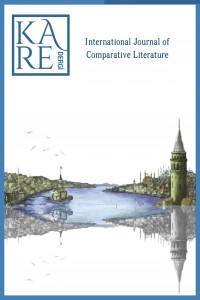Karşılaştırmalı Edebiyat ve Kültürlerarası İletişim: Iris Alanyalı’nın Gebrauchsanweisung Für die Türkei Eserinin İmgebilimsel Bir Analizi
Comparative Literature and Intercultural Communication: an Imagological Analysis of Iris Alanyali's Work Gebrauchsanweisung Für die Türkei
Multicultural societies are one of the research objects that social sciences researchs are particularly focused on. In these societies, cultural, sociological phenomena and problematics are analyzed by many different sciences by various methods and some conclusions are reached. As an important representative of these disciplines comparative literature creates a research area on these societies with the contributions of both imagology and intercultural literary theories. In fact according to various definitions, comparative literature which plays a major role in the providing of intercultural communication examines the relationship of the individual with the "other" in social and psychological dimensions, especially with its one of the research methods imagology oriented studies and focuses on differences and phenomena which are described as foreign through images. In this study, primarily a general definition of comparative literature is given in a theoretical context, and then imagology discussions and the concept and theories of intercultural literature are mentioned in a descriptive way. In application part of this study, the work of Iris Alanyalı who is considered one of the representatives of intercultural literature in Germany, named Gebrauchsanweisung für die Türkei is examined. The most important reason for this work to be chosen is to determine how effective the bicultural identity which is carried by the author in the work written for the German readership about Turkey and Turkish culture. For this research, various concepts of intercultural literary theories and imagology are used. Thus, with its imagological analysis, in the name of intercultural communication what kind of contribution it has is exhibited.
___
- Albrecht, Corinna & Wierlacher, Alois, Benötigt wird profundes Fremdheitswissen. In Alois Wierlacher. (Hrsg.). Kulturthema Kommunikation: Konzepte - Inhalte - Funktionen. Festschrift und Leistungsbild des Instituts für Internationale Kommunikation und Auswärtige Kulturarbeit (IIK Bayreuth) aus Anlass seines zehnjährigen Bestehens 1990-2000. Möhnesee, 2000.
- Alanyalı, İris, Gebrauchsanweisung für die Türkei, Piper Verlag, München, 2006.
- Aytaç, Gürsel, Karşılaştırmalı Edebiyat Bilimi, Ankara: Gündoğan, 1997.
- Barmeyer, C. I./ Genkova, P. /Scheffer, J. (Hg.): Interkulturelle Kommunikation und Kulturwissenschaft. Grundbegriffe, Wissenschaftsdisziplinen, Kulturräume. Passau, Verlag Karl Stutz, 2011.
- Baytekin, Binnaz, Kuramsal ve Uygulamalı Karşılaştırmalı Edebiyat Bilim, Sakarya Yayıncılık, Sakarya, 2006.
- Bierhoff, Hans-Werner / Frey, Dieter, Handbuch der Sozialpsychologie und Kommunikationspsychologie, Göttingen: Hogrefe, 2006.
- Bundesregierung, Der Nationale Integrationsplan Neue Wege – Neue Chancen https://www.bundesregierung.de/resource/blob/975226/441038/acdb01cb90b28205d452c83d2fde84a2/2007-08-30-nationaler-integrationsplan-data.pdf?download=1 (Son erişim Tarihi: 11.05.2021).
- Dysernick, Hugo, Komparatistik als Europaforschung, in: Komparatistik und Europaforschung. Perspektiven vergleichender Literatur- und Kulturwissenschaft, hg. von Hugo Dyserinck u. Karl Ulrich Syndram, Bonn, Berlin, 1992.
- Dyserinck, Hugo, Komparatistische Imagologie Jenseits von Werkimmanenz und Werktranszendenz, in: Synthesis, Bulletin du Comité National Littérature Comparée de la République Socialiste de Roumanie, Vol. 9, Bucarest, 1982.
- Elberfeld, Rolf,Interkulturalität. In: Ralf Konersmann (Hg.): Handbuch Kulturphilosophie. Stuttgart/Weimar: Metzler, 2012.
- Tanzer, Harald, Deutsche Literatur türkischer Autoren, in: Schenk, Klaus (Hg.): Migrationsliteratur. Schreibweisen einer interkulturellen Moderne, Tübingen, 2004. Hofmann, Michael,Interkulturelle Literaturwissenschaft. Eine Einführung. Paderborn: Wilhelm Fink,2006.
- Hoffman, Johannes, Stereotypen, Vorurteile, Völkerbilder in Ost und West in Wissenschaft und Unterricht, eine Bibliographie, Wiesbaden,Harrassowiyz Verlag, 2008. Kefeli, Emel, Karşılaştırmalı Edebiyat İncelemeleri, Kitapevi, İstanbul, 2000.
- Kızıler Emer, Funda, Imagologie als Arbeitsbereich der Komparatistik - Uluslararası Avrasya Sosyal Bilimler Dergisi - Vol.3 - pp.1 - ISSN : 2146-1961, 2012.
- Kızıler Emer, Funda, Karşılaştırmalı Edebiyat Bilimine Genel Bir Bakış, Proceedings Book of 2nd International Scientific Researches Congress on Humanities and Social Sciences (IBAD-2017) , Ed. Hayrullah Kahya, İstanbul, 2017.
- Kula, Onur Bilge,, Alman Kültüründe Türk İmgesi, Cilt 1, Gündoğan Yayınları, Ankara,1992.
- Kuruyazıcı, Nilüfer, Almanya’da Oluşan Yeni Bir Yazının Tartışılması, Ed: Mahmut Karakuş, Nilüfer Kuruyazıcı, Gurbeti Vatan Edenler, Almanca Yazan Almanyalı Türkler, İstanbul, Kültür Bakanlığı Yayınları, 2001.
- Langenscheidt Almanca – Türkçe Sözlük https://tr.langenscheidt.com/almanca-turkce/gebrauchsanleitung
- Nicklas, Pascal Komparatistik als Kulturwissenschaft ? Komparatistik Jahrbuch der Deutschen Gesellschaft für Allgemeine und Vergleichende Literaturwissenschaft, Heidelberg: Synchron Wissenschaftsverlag der Autoren ,2005.
- Said, Edward W., Şarkiyatçılık, Batı’nın Şark Anlayışları, İstanbul: Metis, 2013.
- Ulağlı, Serhat, İmgebilim “Ötekinin” bilimine Giriş, Sinemis Yayınları, Ankara, 2006.
- Wellek, René – Warren, Austin, Edebiyat Teorisi, çeviren: Ö. Faruk Huyugüzel, Dergah Yayınları, İstanbul, 2011.
- Yeşilada, Karin, „‚Nette Türkinnen von nebenan‘ – Die neue deutsch-türkische Harmlosigkeit als literarischer Trend“, İçinde: Schmitz, Helmut (Hg..): Von der nationalen zur internationalen Literatur. Transkulturelle deutschsprachige Literatur und Kultur im Zeitalter globaler Migration, Amsterdamer Beiträge zur neueren Germanistik (69), Amsterdam, New York, 2009.
- ISSN: 2536-4596
- Yayın Aralığı: Yılda 2 Sayı
- Başlangıç: 2016
- Yayıncı: Hasan BAKTIR
Sayıdaki Diğer Makaleler
Fatma Akerson’un Eserlerinde Anlatıcıların Rolü
Türkiye’de Germanistik Alanında Yürütülen Karşılaştırmalı Çalışmalar
Kurgudan Sinemaya José Saramago’nun Körlük Adlı Eserinin İncelenmesi
Türk ve Rus Mitolojisinde Hayvan Mitleri
D.H. Lawrence’ın Âşık Kadınlar ve Toni Morrison’ın Sula Adlı Eserlerinde Toplumsal Yaşamda Kadın
Tema Araştırmasına Bir Katkı Olarak Edebiyatta Mekân ve Edebi Mekân
